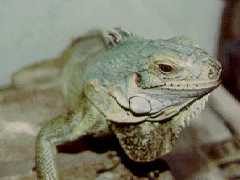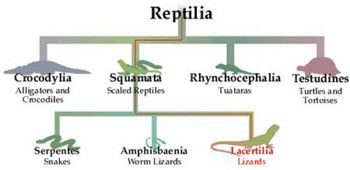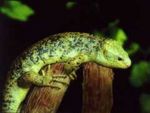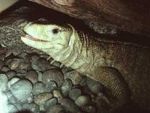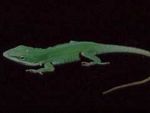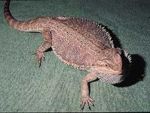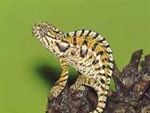Difference between revisions of "Lizard Taxonomy and Identification"
| Line 31: | Line 31: | ||
==Common species== | ==Common species== | ||
| − | There are 22 families of lizards, comprising approximately 3,800 species. About 20 species are commonly kept in captivity. The green iguana is the most popular. There are two poisonous species, the Gila monster and the Mexican beaded lizard, | + | There are 22 families of lizards, comprising approximately 3,800 species. About 20 species are commonly kept in captivity. The green iguana is the most popular. There are two poisonous species, the Gila monster and the Mexican beaded lizard; their venom is not usually deadly but they can inflict extremely painful bites due to powerful jaws. However, it is unlikely to see them often in practice. |
| − | |||
==Identification== | ==Identification== | ||
Revision as of 15:41, 19 February 2010
| This article is still under construction. |
|
|
With their growth in popularity as domestics pets, lizards are being presented to veterinary surgeons in increasing numbers. They are a diverse group of animals and can often pose problems for vets who have seldom, or perhaps never, handled them.
Introduction
Lizards occur on all continents, except Antarctica, and on most tropical and subtropical oceanic islands. This widespread occurrence denotes their broad ecological, physiological, and behavioural adaptations to extremely hot or cold climates, extremely arid to freshwater and marine habitats, and lowland to high-elevation regions. Their highest species diversity appears to be in semiarid habitats; for example, 53 species of lizards occur at one site in the Great Victoria Desert, Australia, and in some areas, particularly islands, densities can be greater than 3000 per hectare.
Taxonomy
Reptiles are ectothermic vertebrates with scales or plates, right and left aortic arches, a partially divided heart and a single occipital condyle.
Lizards are a very large and widespread group of the reptilian order Squamata. The nearly 7200 species of lizards are the most diverse and speciose living clade of reptiles; of course this total includes the worm lizards and snakes (which are actually reduced-limbed or limbless lizards). However, because snakes are a monophyletic group arising from within a group of lizards, the taxon Serpentes and its definition delimit a monophyletic group. Herein, the term lizard represents our shared perception and excludes Serpentes and Amphisbaenia.
The tuatara is a reptile endemic to New Zealand which, though it resembles most lizards, is actually part of a distinct lineage, order Sphenodontia. Lizards and snakes share a movable quadrate bone, distinguishing them from the sphenodonts which have a more primitive and solid diapsid skull.
Common species
There are 22 families of lizards, comprising approximately 3,800 species. About 20 species are commonly kept in captivity. The green iguana is the most popular. There are two poisonous species, the Gila monster and the Mexican beaded lizard; their venom is not usually deadly but they can inflict extremely painful bites due to powerful jaws. However, it is unlikely to see them often in practice.
Identification
Given the range of species, identification can be difficult. However, the most common lizards you are likely to see in practice can be viewed here.
Green Iguana
Iguana iguana. The green iguana is the most common pet lizard and is found free-ranging in the tropical and subtropical regions of Mexico to Southern Brazil. This herbivorous lizard often suffers from metabolic bone disease in captivity due to inadequate husbandry. A suitable temperature range is 29-39°C.
Skink
Corucia zebrata. The prehensile-tailed skink is a very large skink. They reach a maximum length of 80cm, half of which is composed of a fully prehensile tail. The dorsal surface has a grey/green background and is speckled black. The chin is yellow and the underside pale. They have become popular terrarium animals due to their easy husbandry, large size and unusual appearance.
Monitor Lizard
Varanus spp. Monitor lizards are mostly large powerful predators or carrion eaters. The family includes the savannah monitor (varanus exanthematicus), Nile monitor (varanus niloticus) and the Komodo dragon (varanus komodoensis).
Green Anole
Anolis carolinensis. Green anoles are diurnal and semi-arboreal. They are slender lizards with long tails (fragile and readily lost) and a pointed head. They will grow from hatchling (5 to 6cm) to small adult size in 6 to 8 months and, if maintained properly, have a typical lifespan of 3 to 6 years.
Bearded Dragon
Pogona vitticeps. This lizard is diurnal. Adults grow to 50 cm and have a blunt arrow-shaped head. Scales along the skin of the throat and the side of the head and body have specialized into spiny points.
Chameleon
Chamaeleo spp. Chameleons are considered among the more delicate of lizards. Anatomical differences from other lizards may include astonishingly long tongues, ability for colour change, oppositely opposable digits and prehensile tails. They are generally viviparous.
